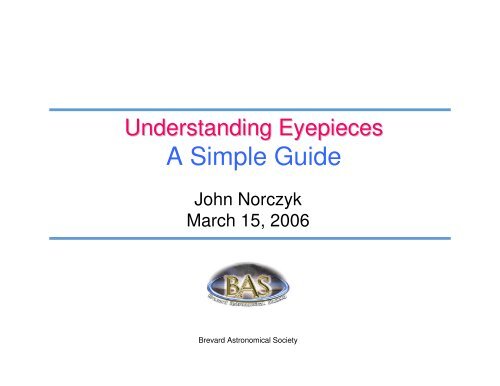Understanding Eyepieces - the Brevard Astronomical Society
Understanding Eyepieces - the Brevard Astronomical Society
Understanding Eyepieces - the Brevard Astronomical Society
You also want an ePaper? Increase the reach of your titles
YUMPU automatically turns print PDFs into web optimized ePapers that Google loves.
<strong>Understanding</strong> <strong>Eyepieces</strong><br />
A Simple Guide<br />
John Norczyk<br />
March 15, 2006<br />
<strong>Brevard</strong> <strong>Astronomical</strong> <strong>Society</strong>
So you bought a new<br />
telescope.<br />
<strong>Brevard</strong> <strong>Astronomical</strong> <strong>Society</strong>
A neat set of<br />
eyepieces<br />
came in <strong>the</strong><br />
box.<br />
They’re all so<br />
pretty.<br />
Which one<br />
should I<br />
choose<br />
<strong>Brevard</strong> <strong>Astronomical</strong> <strong>Society</strong>
Let’s see.<br />
Magnification =<br />
Focal Length of <strong>the</strong> Telescope<br />
Focal Length of <strong>the</strong> Eyepiece<br />
<strong>Brevard</strong> <strong>Astronomical</strong> <strong>Society</strong>
Eyepiece focal length is almost<br />
universally expressed in millimeters.<br />
It’s best to change any measurements<br />
in inches to millimeters<br />
by multiplying inches by 25.4<br />
<strong>Brevard</strong> <strong>Astronomical</strong> <strong>Society</strong>
An 8” f/6 telescope<br />
has a focal length of 48”..<br />
48” multiplied by 25.4mm/”<br />
results in 1220 mm.<br />
<strong>Brevard</strong> <strong>Astronomical</strong> <strong>Society</strong>
A 12mm eyepiece will<br />
produce a magnificaton of<br />
1220mm<br />
12mm<br />
Very close to 102x.<br />
<strong>Brevard</strong> <strong>Astronomical</strong> <strong>Society</strong>
An 18mm eyepiece will<br />
produce a magnification of<br />
1220mm<br />
18mm<br />
Very close to 68x.<br />
<strong>Brevard</strong> <strong>Astronomical</strong> <strong>Society</strong>
A 25mm eyepiece will<br />
produce a magnification of<br />
1220mm<br />
25mm<br />
Very close to 49x.<br />
<strong>Brevard</strong> <strong>Astronomical</strong> <strong>Society</strong>
That’s all <strong>the</strong>re is to it.<br />
Thank your for your<br />
kind attention.<br />
<strong>Brevard</strong> <strong>Astronomical</strong> <strong>Society</strong>
Wait a minute!<br />
There’s More!<br />
<strong>Brevard</strong> <strong>Astronomical</strong> <strong>Society</strong>
Lenses focus<br />
light by<br />
REFRACTION.<br />
This is called<br />
Chromatic Aberration.<br />
COLORS do not<br />
focus <strong>the</strong> same way.<br />
<strong>Brevard</strong> <strong>Astronomical</strong> <strong>Society</strong>
<strong>Eyepieces</strong> are<br />
composed of a<br />
combination of lenses<br />
to correct for color.<br />
These lens combinations<br />
are called achromats.<br />
<strong>Brevard</strong> <strong>Astronomical</strong> <strong>Society</strong>
There are a number of<br />
eyepiece designs.<br />
<strong>Brevard</strong> <strong>Astronomical</strong> <strong>Society</strong>
http://www.daviddarling.info/encyclopedia/E/eyepiece.html<br />
<strong>Brevard</strong> <strong>Astronomical</strong> <strong>Society</strong>
ORTHOSCOPIC<br />
Considered<br />
by many to be a good<br />
choice for lunar<br />
and planetary work.<br />
Tend to have a narrow<br />
field of view.<br />
<strong>Brevard</strong> <strong>Astronomical</strong> <strong>Society</strong>
PLOSSL<br />
Wider field of view<br />
than ORTHOSCOPIC.<br />
Probably <strong>the</strong> most<br />
popular eyepiece.<br />
A good all-around<br />
around<br />
performer.<br />
<strong>Brevard</strong> <strong>Astronomical</strong> <strong>Society</strong>
ERFLE<br />
Wide field of view.<br />
Performs best at low<br />
power for wide field<br />
observations.<br />
<strong>Brevard</strong> <strong>Astronomical</strong> <strong>Society</strong>
KELLNER<br />
Good choice for<br />
“beginner” telescopes.<br />
<strong>Brevard</strong> <strong>Astronomical</strong> <strong>Society</strong>
NAGLER<br />
&<br />
Super Wide<br />
Wide field of view.<br />
<strong>Brevard</strong> <strong>Astronomical</strong> <strong>Society</strong>
Light Loss and Ghosts<br />
Anti-reflection<br />
coatings help<br />
reduce internal reflections and<br />
“ghosts”.<br />
Each lens surface reduces light<br />
and contrast.<br />
<strong>Brevard</strong> <strong>Astronomical</strong> <strong>Society</strong>
Field of View<br />
This may range from<br />
about 40 o to 80 o .<br />
Each eyepiece design<br />
produces an apparent<br />
field of view.<br />
<strong>Brevard</strong> <strong>Astronomical</strong> <strong>Society</strong>
Actual Field of View<br />
The actual field of view<br />
can be calculated.<br />
FOV =<br />
APPARENT FIELD OF VIEW<br />
MAGNIFICATION<br />
<strong>Brevard</strong> <strong>Astronomical</strong> <strong>Society</strong>
Actual Field of View<br />
An eyepiece has a 50 o<br />
apparent field of view<br />
and produces a<br />
100x magnification.<br />
FOV =<br />
50 o<br />
100<br />
= .5 o<br />
<strong>Brevard</strong> <strong>Astronomical</strong> <strong>Society</strong>
<strong>Brevard</strong> <strong>Astronomical</strong> <strong>Society</strong>
Measuring Field of View<br />
FOV=15’ x time minutes<br />
FOV=15” x time seconds<br />
<strong>Brevard</strong> <strong>Astronomical</strong> <strong>Society</strong>
Exit Pupil<br />
7mm<br />
<strong>Brevard</strong> <strong>Astronomical</strong> <strong>Society</strong>
Exit Pupil<br />
A 600 mm (24”)<br />
telescope operating<br />
at 100x .<br />
Exit Pupil =<br />
Aperture .<br />
Magnification<br />
Exit Pupil =<br />
600mm .<br />
100x<br />
= 6mm<br />
<strong>Brevard</strong> <strong>Astronomical</strong> <strong>Society</strong>
Eye Relief<br />
The distance between your eye<br />
and <strong>the</strong> eyepiece is referred<br />
to as eye relief.<br />
An eye glass wearer may want to<br />
choose an eyepiece with a greater<br />
eye relief.<br />
<strong>Brevard</strong> <strong>Astronomical</strong> <strong>Society</strong>
Eyepiece Diameter<br />
There is no particular advantage of<br />
one size over ano<strong>the</strong>r except when<br />
wide field of view is desired.<br />
<strong>Eyepieces</strong> come in 3 common<br />
diameters:<br />
0.965” (24.5mm)<br />
1.25” (31.75 mm)<br />
2.0” (50.8 mm)<br />
<strong>Brevard</strong> <strong>Astronomical</strong> <strong>Society</strong>
Barlow Lenses<br />
A Barlow is a negative<br />
lens that increases <strong>the</strong><br />
effective focal length<br />
of <strong>the</strong> telescope.<br />
http://www.astunit.com/tutorials/barlow.htm<br />
<strong>Brevard</strong> <strong>Astronomical</strong> <strong>Society</strong>
Barlow Lenses<br />
http://www.daviddarling.info/encyclopedia/B/Barlow_lens.html<br />
<strong>Brevard</strong> <strong>Astronomical</strong> <strong>Society</strong>
Final Analysis<br />
One big deciding factor<br />
is personal preference.<br />
<strong>Brevard</strong> <strong>Astronomical</strong> <strong>Society</strong>
<strong>Astronomical</strong> Telescope <strong>Eyepieces</strong>:<br />
A Discussion for <strong>the</strong> Beginner<br />
http://www.observers.org/beginner/eyepieces.freeman.htm<br />
Ken’s Eypieces http://www.klhess.com/telespec.htm<br />
Wikepedia http://en.wikipedia.org/wiki/Orthoscopic_Eyepiece<br />
Astronomy Boy: Making Your own eyepieces<br />
http://www.astronomyboy.com/eyepieces/<br />
Barlow Lenses http://www.astunit.com/tutorials/barlow.htm<br />
<strong>Brevard</strong> <strong>Astronomical</strong> <strong>Society</strong>



